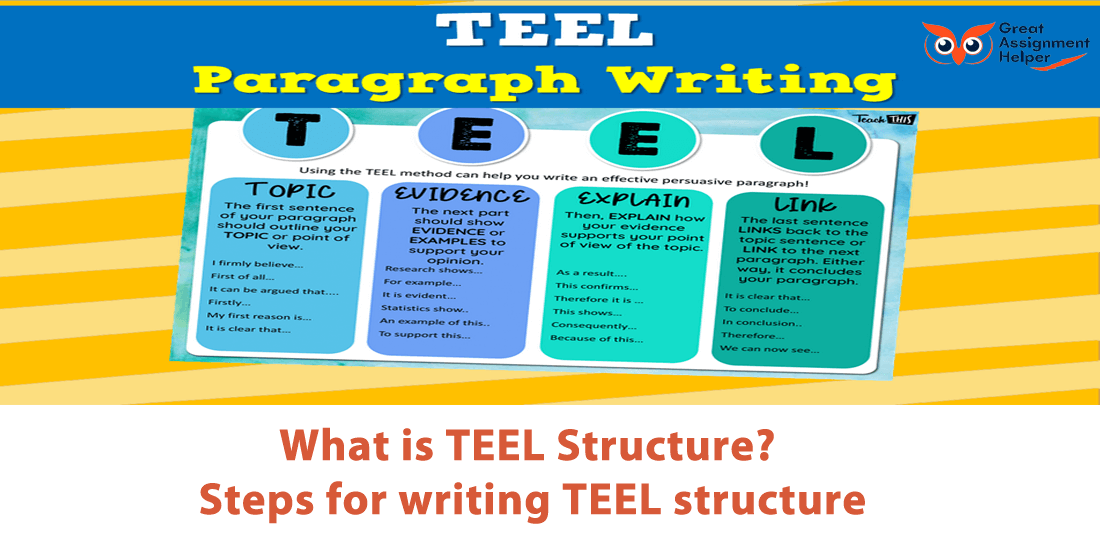
Listen To This Blog
Introduction
Are you struggling to structure your academic writing? Do you find it hard to articulate your thoughts in a clear and concise manner? Look no further as we introduce you to the TEEL structure.
TEEL stands for Topic Sentence, Explanation, Evidence, and Linking Sentence. The TEEL structure is a step-by-step guide to help you organize your thoughts and arguments in a logical and coherent manner. Its importance cannot be overstated, especially for students looking to improve their grades.
In this guide, we will take you through the TEEL structure step-by-step and provide you with practical tips to help you master it. By the end of this guide, you'll be able to produce clear and structured writing that will impress your educators and improve your analytical skills. Let's dive in!
Understanding TEEL Structure
If you want to excel in academic writing, it is essential to have a clear understanding of the TEEL structure. TEEL stands for Topic sentence, Explanation, Evidence, and Linking sentence. This structure is crucial because it helps to present your argument in a logical and organized manner.
Using TEEL structure in academic writing is highly recommended because it helps to:
- Provide a clear structure to your writing, making it easy for the reader to follow your argument.
- Convey information in a structured manner, ensuring that your writing is not only well-organized but also coherent.
- Present persuasive arguments that are backed up by reliable sources.
Here are some examples of TEEL structure in action:
Topic Sentence: The COVID-19 pandemic has had a significant impact on the global economy.
Explanation: The outbreak of the COVID-19 virus has led to the closure of businesses worldwide, causing a significant decline in economic activity.
Evidence: According to the World Bank, the disruption caused by the pandemic is expected to push millions of people into extreme poverty.
Linking Sentence: Therefore, it is critical to implement measures that can support businesses and individuals during this challenging period.
Using the TEEL structure in writing is not complicated, and with practice, one can quickly master it. Remember to keep your topic sentence clear and concise, explain your ideas with relevant information, provide evidence to support your argument, and use appropriate linking sentences that connect your ideas.
In conclusion, using the TEEL structure in academic writing can greatly enhance your writing skills and help you to make persuasive arguments backed by evidence.
Step-by-Step Guide to Using TEEL Structure
So you have been given an essay to write and you're wondering where to start and how to structure it? Look no further, because the TEEL structure is here to save the day!
The TEEL structure is a popular method used in academic writing, designed to help students organize their thoughts in a clear and coherent manner. It stands for Topic sentence, Explanation, Evidence, Linking sentence, and Relevance to the topic.
Step 1: Topic Sentence
This is the main idea of your paragraph, and it should be clear and concise. Start with a sentence that introduces the topic and gives a brief overview of what you will be discussing.
Step 2: Explanation
Now that you've introduced your topic, it's time to explain it further. Provide some background information or context that will help your reader understand what you're talking about.
Step 3: Evidence
This is where you provide evidence to support your argument or claim. This can be incorporated as example, statistical figures or quotes. Make sure that your evidence is relevant and supports your argument.
Step 4: Linking Sentence
The linking sentence is used to tie your evidence back to your main point. It should be logical and help to connect your evidence to your topic sentence.
Step 5: Relevance to the Topic
This is your chance to reflect on how your evidence supports your overall argument and how it relates to the topic of your essay.
That's it! By using the TEEL structure, you can ensure that your paragraph has a clear and logical flow, making it easy for your reader to follow your train of thought. So next time you're struggling with organizing your writing, give TEEL a try, and watch your writing improve!
Common Mistakes to Avoid While Using TEEL Structure
So, you've learned how to use TEEL structure in academic writing, but are you making these common mistakes? Let's dive into what you should avoid when implementing TEEL.
Firstly, it's important to stay relevant to the topic you're discussing. Going off-topic not only shows a lack of focus, but it can also confuse your reader. Secondly, make sure you have a strong and clear topic sentence that serves as a roadmap for your paragraph. Weak topic sentences not only make it hard for your reader to follow your argument, but it may give an impression that you don’t really understand what you are writing about.
Another common mistake is insufficient evidence or explanation. Without these, you can't fully develop your argument. Conversely, providing too much evidence without explaining how it relates to your topic can be equally problematic since it doesn’t allow the reader to fully follow your argument. It is imperative that a perfect balance is struck between the two.
Moreover, you cannot underestimate the use of appropriate linking sentences. They need to connect what you are discussing in the current paragraph with the next one, thereby allowing the reader to follow your train of thought. Misusing linking words can break up the flow of your essay, making it hard to read and understand.
Lastly, it's imperative to avoid plagiarism entirely. Apart from it being an act of academic dishonesty that can lead to consequences, it can also show a lack of creativity and critical thinking skills. Stay original in your work by paraphrasing and citing your sources HONESTLY.
By avoiding these common mistakes, you'll be well on your way to mastering TEEL structure. Remember, practising and using the tips will allow you to reap the benefits of more clear and concise writing, making for a more impressive grade on your next academic essay!
Practical Tips to Help You Master the TEEL Structure
You have learned the basics of TEEL Structure. Now it's time for some practical tips on how to use it effectively in your academic writing.
Research thoroughly: The first step towards mastering the TEEL Structure is researching thoroughly. The more you know about the topic, the easier it gets to write a good essay. Look for credible sources to gather information and evidence.
Plan your thoughts before writing: Before you start writing, make sure you have a clear idea about what you want to say. Plan your thoughts, organize them in a logical order and create an outline to ensure a smooth flow of ideas.
Use linking words appropriately: To connect your ideas and create a seamless flow, use linking words appropriately. Words like "furthermore," "additionally," and "however," can make your writing sound more coherent.
Relevance to the prompt: As you write, keep the prompt in mind. Make sure your writing is relevant to the topic and addresses the prompt.
Clear and concise writing: Writing clearly and concisely is key to mastering TEEL Structure. Be precise in your word choices and avoid repetitive language. Use short sentences to make your point elegantly.
Follow these practical tips, and you'll be on your way to mastering the TEEL Structure in no time!
Benefits of Using TEEL Structure
Using the TEEL structure can have numerous benefits for academic writing. Firstly, it ensures clear and structured writing, which makes your ideas easy to follow and understand. This leads to an easier time for educators grading your work as there are no ambiguities in the presentation of your argument.
Furthermore, the TEEL structure increases the chance of an improved analytical skill set. This is because it forces the writer to think deeply about the content and to organize their thoughts logically. Lastly, the use of the TEEL structure allows for easy navigation of your argument by the reader. Overall, the TEEL structure is an excellent tool for successful academic writing.
Conclusion
Phew! That was quite an informative guide to mastering the TEEL structure. Now you know what it is, why it's important, and how to use it step-by-step. Congratulations, you're already on your way to becoming a confident academic writer!
But wait, there's more! We've listed some common mistakes to avoid and practical tips to help you apply the TEEL structure effectively. Remember, clear and concise writing with relevance to the prompt is the key.
So what are you waiting for? Apply the tips, practice, and watch your writing improve by leaps and bounds with essay help for students. Trust me, your educators will love the structured approach, making grading a lot easier for them.
In conclusion, the TEEL structure is a powerful tool that can benefit all academic writers. Mastering it takes time, patience, and practice, but the rewards are worth it. So go ahead, give it a shot, and watch your writing flourish!

